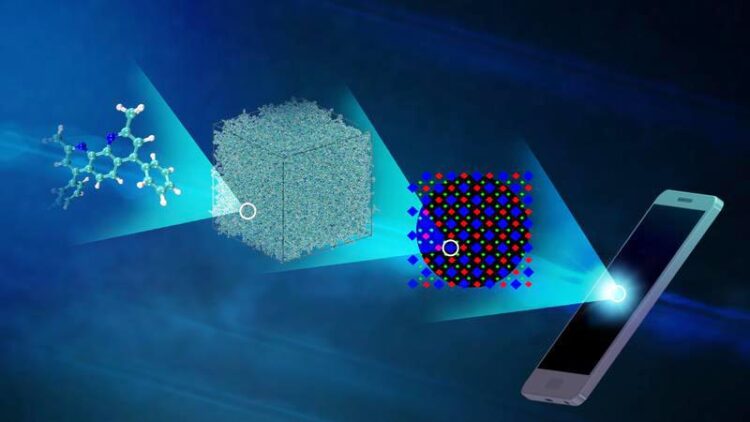A library of … organic molecules

The properties of OLEDs based on the structure of the molecules used could be predicted in the future entirely by computer simulations.
© MPI-P
From modern smartphones to televisions: organic light-emitting diodes (OLEDs) are an emerging technology that promises, among other benefits, excellent image contrast and low power consumption. The complexity of an OLED pixel makes it difficult to design new molecular materials. Denis Andrienko, group leader at the Max Planck Institute for Polymer Research, and his team have now compared a wide range of computer-simulated and experimentally measured properties of OLED thin films, trying to understand whether OLED design can be guided solely by computer.
In contrast to conventional light-emitting diodes (LEDs), organic LEDs (OLEDs) are no longer made of silicon. In OLEDs, thin layers of carbon-based molecules form pixels, which emit light. The color of a pixel can be adjusted by varying the molecular structure. OLED pixels normally consist of multiple layers which ensure, for example, that electrons can travel in the pixel with as little resistance as possible. The fine-tuning of the layer properties, for example, electron mobility or the emitted wavelength (color of the light), is a complex task.
Denis Andrienko, group leader at the Max Planck Institute for Polymer Research (MPI-P) in the department “Theory of Polymers” headed by Prof. Kurt Kremer, has now joined forces with scientists of the Ukrainian Institute of Physics, the department of Molecular Electronics at MPI-P, as well as Merck KGaA, Darmstadt, Germany. Together, they tested the accuracy of computer-based predictions of properties of thin OLED layers.
For this purpose, they have established a molecular library of typical OLED materials. The idea of this library is to streamline the design of new molecular structures and to simulate the properties of the corresponding thin layers. The benefit is that this can be done prior to (expensive) synthesis, layer deposition, and characterization of an entire OLED.
“In the future, we hope that our simulation protocols can be used to design molecular structures with given properties,” the co-author of the paper, Leanne Paterson, says.
The scientists simulated and measured various parameters of OLED layers and found good correlations for some properties and consistent trends for others. Their results are now published in Chemical Physics Reviews and highlighted on AIP’s Scilight. The material library is open for other researches and can be downloaded from the GitLab of the Max Planck Computing and Data Facility.
Wissenschaftliche Ansprechpartner:
Dr. Denis Andrienko
+49 6131 379-147
andrienk@mpip-mainz.mpg.de
Originalpublikation:
Molecular library of OLED host materials—Evaluating the multiscale simulation workflow
Chem. Phys. Rev. 2, 031304 (2021), DOI: https://dx.doi.org/10.1063/5.0049513
Media Contact
All latest news from the category: Materials Sciences
Materials management deals with the research, development, manufacturing and processing of raw and industrial materials. Key aspects here are biological and medical issues, which play an increasingly important role in this field.
innovations-report offers in-depth articles related to the development and application of materials and the structure and properties of new materials.
Newest articles

Innovative 3D printed scaffolds offer new hope for bone healing
Researchers at the Institute for Bioengineering of Catalonia have developed novel 3D printed PLA-CaP scaffolds that promote blood vessel formation, ensuring better healing and regeneration of bone tissue. Bone is…

The surprising role of gut infection in Alzheimer’s disease
ASU- and Banner Alzheimer’s Institute-led study implicates link between a common virus and the disease, which travels from the gut to the brain and may be a target for antiviral…

Molecular gardening: New enzymes discovered for protein modification pruning
How deubiquitinases USP53 and USP54 cleave long polyubiquitin chains and how the former is linked to liver disease in children. Deubiquitinases (DUBs) are enzymes used by cells to trim protein…



